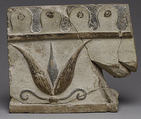Terracotta architectural tile
This brightly painted, mold-made tile is one of many that have been excavated at Sardis, the capital of the ancient kingdom of Lydia, in southern Turkey. In places like Lydia and southern Italy, where native stone was scarce or of poor quality, terracotta served as a substitute for stone in architecture. Tiles such as this one would have originally decorated the rooflines and outer walls of houses and civic buildings. Being both decorative and functional, some are equipped with a protruding spout that helped drain water from the eaves.
Due to rights restrictions, this image cannot be enlarged, viewed at full screen, or downloaded.

